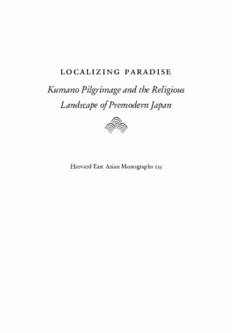
Localizing Paradise: Kumano Pilgrimage and the Religious Landscape of Premodern Japan PDF
Preview Localizing Paradise: Kumano Pilgrimage and the Religious Landscape of Premodern Japan
localizing paradise Kumano Pilgrimage and the Religious Landscape of Premodern Japan p Harvard East Asian Monographs 235 localizing paradise Kumano Pilgrimage and the Religious Landscape of Premodern Japan p D. Max Moerman Published by the Harvard University Asia Center Distributed by Harvard University Press Cambridge (Massachusetts) and London 2005 © 2005 by the President and Fellows of Harvard College Printed in the United States of America The Harvard University Asia Center publishes a monograph series and, in coordination with the Fairbank Center for East Asian Research, the Korea Institute, the Reischauer Insti- tute of Japanese Studies, and other faculties and institutes, administers research projects de- signed to further scholarly understanding of China, Japan, Vietnam, Korea, and other Asian countries. The Center also sponsors projects addressing multidisciplinary and regional issues in Asia. Library of Congress Cataloging-in-Publication Data Moerman, D. Max (David Max) Localizing paradise : Kumano pilgrimage and the religious landscape of premodern Japan / D. Max Moerman. p. cm. -- (Harvard East Asian monographs ; 235) Includes bibliographic references and index. isbn 0-674-01395-6 (cloth : alk. paper) 1. Kumano Region (Japan)--Religion 2. Kumano Hayatama Jinja (Shingū-shi, Japan). 3. Kumano Nachi Jinja (Nachikatsuura-chō, Japan). 4. Kumano Hongūsha (Natori-shi, Japan).. I. Title: Kumano pilgrimage and the religious landscape of premodern Japan. II. Series. bl2215.k84m64 2005 299.5'6135'0952184--dc22 2005004387 Index by Anne Holmes of EdIndex Printed on acid-free paper Last figure below indicates year of this printing 14 13 12 11 10 09 08 07 06 05 For Carin and Thea Acknowledgments p All pilgrims rely on guides and I would have lost my way countless times, indeed would not have even been able to begin this journey, without the guidance of many. More individuals have inspired, in- structed, encouraged, and supported me along this path than can be acknowledged here. I would, however, like to express my deep gratitude to those without whom this book would not have been possible. At Stanford I was fortunate to have had such exemplary teachers as Carl Bielefeldt, Bernard Faure, Jeffrey Mass, Susan Matisoff, Melinda Takeuchi, and Jan Nattier. My debt to each of them is immense. I began my studies as an undergraduate at Co- lumbia and Barnard, and even though I occupy a different place in those same halls today, my tutelage continues. I am pleased to be able to count a few of my past professors among my present men- tors and to have found a rich intellectual community of new col- leagues as well. I have benefited greatly from the critical advice of Ryūichi Abé, Paul Anderer, Irene Bloom, Jack Hawley, Bob Hymes, Rachel McDermott, Haruo Shirane, and Henry Smith. I must also extend my gratitude to Allan Grapard, Edward Kamens, Ian Reader, Fabio Rambelli, Jacqueline Stone, Paul Swanson, and especially Mimi Yiengpruksawan. Their scholarship has illumined my path and their comments and suggestions guided me through- viii (cid:120) Acknowledgments out the journey. What value the reader might find in these pages is due to the influence of these many teachers; its many shortcomings are mine alone. In Japan I am particularly indebted to Imai Masaharu of Tsu- kuba University, Sueki Fumihiko of Tokyo University, Matsuo Kenji of Yamagata University, and Ogawa Nobuhiko of Nara Joshi University. Minoru and Motoko Okuda first took me under their wing and into their home twenty years ago and have been a constant source of kindness and generosity ever since. Risaku Su- zuki, ujiko and fellow Kumano pilgrim, and Takako Matsuda led me through the mountains and allowed for visions and experiences of Kumano I would never otherwise have known. The initial research of this work was made possible by the gen- erous support of the Center for East Asian Studies and the Institute for International Studies at Stanford University, the Social Science Research Council, the American Council of Learned Societies, and the Mabelle McLeod Lewis Memorial Fund. I am grateful as well for the assistance and expertise of the librarians and staff at Co- lumbia’s Starr East Asian Library, at Bukkyō University Library in Kyoto, at Kokugakuin University Library in Tokyo, at the Shingū Municipal Library, and at the Kyoto National Museum. My greatest thanks, however, is reserved for my parents, Marianne and Michael Moerman. D.M.M. Contents p Illustrations xi Chronology xv 1 Situating Kumano 1 The Place and Path of Kumano Pilgrimage 5/ Institutional and Economic Structures 18/ Picturing Kumano 24/ Structure and Agenda 36 2 Emplacements 42 The Land of Origins 43/ Sites of Asceticism 47/ Translocated Genealogies 57/ Multiple Paradises 62/ Esoteric Cartographies 75/ Institutional Portraits 84 3 Mortuary Practices 92 Suicide and Salvation 93/ Funereal Pilgrimage 117/ Return Pas- sage 128/ Memorial Rites 134 4 The Theater of State 139 The Political Landscape 150/ Imperial Progress and Institutional Growth 160/ Religious Politics and Buddhist Kingship 171/ Paradises Future and Past 177 x (cid:120) Contents 5 A Woman’s Place 181 Gender and the Ambiguities of Enlightenment 186/ Female Trouble 194/ Exclusion and Transgression 199/ Buddhist Matriarchies 208/ A Second Genesis 216/ A Hell of One’s Own 221 Conclusion: An Ambivalent Utopia 233 Reference Matter Works Cited 245 Character List 269 Index 279
